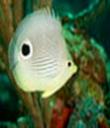Bicolor Angelfish
Scientific Name : Centropyge bicolor
Common Names : Bicolor Angelfish, Gold and Blue Angelfish, Oriole Angelfish, Boray-boray, Two color angel
Care Level : Moderate
Size : Up to 6 inches (15 cm)
Life span : 5 – 10 years or longer in the wild
pH : 8.1 – 8.4
Temperature : 72°F – 80°F (22°C – 27°C)
Specific Gravity : 1.020 – 1.025
Carbonate Hardness (dKH) : 8 – 12°
Origin / Habitat : Indo-Pacific near Japan down to Australia
Temperament / Behavior : They can be aggressive with others, especially other dwarf marine angelfishes. It’s not the best choice for a reef tank because they are known to nip lps corals.
Breeding / Mating / Reproduction : Very difficult to breed in captivity partly due to their aggressive nature with members of their own species. They are hermaphrodites and practice harem breeding.
Tank Size : 30 gallon (113 liters) minimum, preferrably larger to provide adequate swimming room.
Compatible Tank Mates : Only one dwarf angelfish per tank, unless the aquarium is extremely large. They may nip lps corals and sometimes pick on smaller invertebrates.
Reef Tank Compatible? : Can help control algae if in small amounts, but can nibble at corals, clams and other invertebrates.
Fish Disease : Saltwater Fish Disease – Diagnose, Symptoms and Treatment
Diet / Fish Food : Frequent (2 times per day) and varied feedings. Try to give them a variety of marine foods but predominantly marine algae and spirulina. Live rock is a welcome addition to the tank since it will provide grazing opportunities in between meals. They are not very picky and should go after flakes and frozen fish food.
Tank Region : Usually middle to bottom
Gender : No reliable way to determine the differences between males and females.
Gallery Photos : Bicolor Angel fish Photos
The front half of the Bicolor Angelfish (Two Color Angelfish) is yellow, the back half is a royal blue and they have a “saddle” like blue over the eye region. This is dwarf angelfish that is commonly available at the saltwater fish store and is usually in the $20-$30 price range. Although this fish is not as colorful as the Flame Angelfish it is still quite striking and will make a beautiful addition to the right saltwater tank setup.
The Bicolor Angel has a reputation as being difficult to keep and are deemed not as hardy as some of the other dwarf angelfishes. It may depend on the location they are coming from because some of the fish collectors may have questionable collecting practices. With that little tidbit in mind you may want to take some extra time when acclimating them to your saltwater aquarium. Only add them to well-established tanks, preferrably an aquarium that has been setup up for at least 6 months.
In the wild they can be somewhat reclusive, not venturing far from their hiding places in the rock. It is a good idea to provide plenty of hiding places in your tank as well since it should help make them feel more secure. Providing live rock has a secondary benefit of being a food source that will allow them to graze in between meals. Feeding them is not difficult since they should go after most fish foods including frozen and flakes but some hobbyists have reported that this is not the case. If you have difficulty getting yours to start eating, try frozen or live foods at first and then slowly wean them onto other fish food. Try to give them foods enriched with spirulina. Some frozen cubes are enriched with spirulina.
Only one of the dwarf angels per tank! Even though they are seen in pairs or even small groups in the ocean, they will not tolerate each other in the small confines of the home marine aquarium. If you have a sufficiently large tank you may be able to get away with multiples if they are introduced at the same time and if they have plenty of hiding places.




